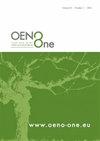Fungitoxic role of endogenous eugenol in the hybrid grapevine cultivar Baco blanc resistant to Botrytis cinerea
IF 2.2
3区 农林科学
Q3 FOOD SCIENCE & TECHNOLOGY
引用次数: 1
Abstract
Eugenol (2-methoxy-4-(2-propenyl)-phenol), widely spread in various plants, notably clove, basil and bay, is a well-known antifungal and antibiotic molecule that is abundant in the hybrid grapevine cultivar Baco blanc (Vitis vinifera × Vitis riparia × Vitis labrusca). This variety, created by François Baco (19th century), is confirmed in this study as highly resistant to Botrytis cinerea by comparing fruit rot incidence and severity with two Vitis vinifera cultivars: Folle Blanche and Ugni Blanc. According to two major antibiosis modes of action, i.e., direct or volatile, this study demonstrated the efficiency of eugenol in vitro by also investigating precisely the effect on B. cinerea of small concentrations of eugenol, 3 to 4 ppm, corresponding to IC10. Moreover, the vapour-inhibiting effect was shown to be highly powerful. The total eugenol concentration peaked at the veraison stage, exceeding 1000 μg×kg-1 in the skin of Baco blanc berry under our conditions. At this point, leaf removal in the bunch zone induced a significant increase in eugenol (32 %), from 1118 to 1478 μg×kg-1, which was also associated with a significant decrease in B. cinerea infection in the vineyard. Thus, for the first time, eugenol, as an endogenous molecule of Baco blanc, was clearly demonstrated to be an inducible compound in the vineyard. Furthermore, significant intravarietal variability in eugenol concentrations according to the Baco blanc clone was demonstrated to be associated with significant differences in fruit susceptibility to the plant pathogen assessed in biotests. Interestingly, in keeping with fruit ontogenic resistance, a significant negative correlation was established between the technological maturity of berries and the total eugenol content in the berry skin. Finally, the time-progress study of the two biochemical forms of eugenol (bound vs. free eugenol) allowed us to hypothesise the effectiveness against the plant pathogen of some precursor forms of eugenol, and the corresponding biochemical structures are currently being investigated. Thus, eugenol appears to be a key biochemical marker of ontogenic resistance in the hybrid cultivar Baco blanc.内源丁香酚在抗灰霉病葡萄杂交品种白烟中的抑菌作用
Eugenol(2-甲氧基-4-(2-丙烯基)-苯酚)广泛分布于各种植物中,尤其是丁香、罗勒和月桂树,是一种著名的抗真菌和抗生素分子,在杂交葡萄品种Baco blanc(Vitis vinifera×Vitis riparia×Vitis labrusca)中含量丰富。该品种由François Baco(19世纪)创造,通过与两个葡萄品种Folle Blanche和Ugni Blanc比较果实腐烂的发生率和严重程度,本研究证实该品种对灰葡萄孢具有高度抗性。根据两种主要的抗菌作用模式,即直接或挥发性,本研究通过精确研究小浓度丁香酚(3至4ppm,对应IC10)对灰葡萄球菌的影响,证明了丁香酚在体外的有效性。此外,蒸汽抑制作用被证明是非常强大的。在我们的条件下,白浆果皮中丁香酚的总浓度在veraison阶段达到峰值,超过1000μg×kg-1。在这一点上,束区的叶片去除导致丁香酚显著增加(32%),从1118μg×kg-1增加到1478μg·kg-1,这也与葡萄园中灰葡萄球菌感染的显著减少有关。因此,丁香酚作为白曲霉的内源性分子,首次在葡萄园中被明确证明是一种可诱导的化合物。此外,根据Baco blanc克隆,优生学浓度的显著品种内变异被证明与生物测试中评估的果实对植物病原体易感性的显著差异有关。有趣的是,与果实个体发生抗性一致,浆果的技术成熟度与浆果皮中丁香酚的总含量之间存在显著的负相关。最后,对丁香酚的两种生物化学形式(结合丁香酚与游离丁香酚)的时间进展研究使我们能够假设丁香酚某些前体形式对植物病原体的有效性,相应的生物化学结构目前正在研究中。因此,丁香酚似乎是杂交品种Baco blanc个体发生抗性的关键生化标记。
本文章由计算机程序翻译,如有差异,请以英文原文为准。
求助全文
约1分钟内获得全文
求助全文
来源期刊

OENO One
Agricultural and Biological Sciences-Food Science
CiteScore
4.40
自引率
13.80%
发文量
85
审稿时长
13 weeks
期刊介绍:
OENO One is a peer-reviewed journal that publishes original research, reviews, mini-reviews, short communications, perspectives and spotlights in the areas of viticulture, grapevine physiology, genomics and genetics, oenology, winemaking technology and processes, wine chemistry and quality, analytical chemistry, microbiology, sensory and consumer sciences, safety and health. OENO One belongs to the International Viticulture and Enology Society - IVES, an academic association dedicated to viticulture and enology.
 求助内容:
求助内容: 应助结果提醒方式:
应助结果提醒方式:


